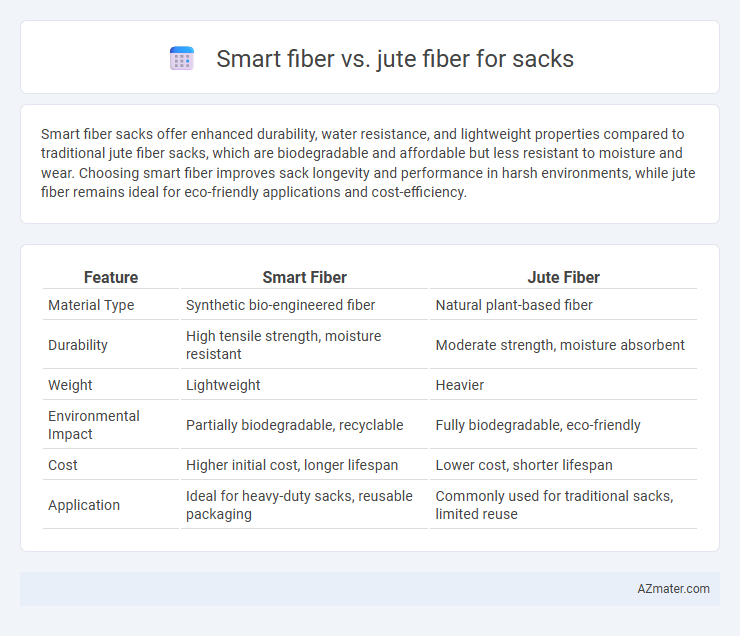Smart fiber sacks offer enhanced durability, water resistance, and lightweight properties compared to traditional jute fiber sacks, which are biodegradable and affordable but less resistant to moisture and wear. Choosing smart fiber improves sack longevity and performance in harsh environments, while jute fiber remains ideal for eco-friendly applications and cost-efficiency.
Table of Comparison
| Feature | Smart Fiber | Jute Fiber |
|---|---|---|
| Material Type | Synthetic bio-engineered fiber | Natural plant-based fiber |
| Durability | High tensile strength, moisture resistant | Moderate strength, moisture absorbent |
| Weight | Lightweight | Heavier |
| Environmental Impact | Partially biodegradable, recyclable | Fully biodegradable, eco-friendly |
| Cost | Higher initial cost, longer lifespan | Lower cost, shorter lifespan |
| Application | Ideal for heavy-duty sacks, reusable packaging | Commonly used for traditional sacks, limited reuse |
Introduction to Sack Materials: Smart Fiber vs Jute Fiber
Smart fiber sacks offer enhanced durability, moisture resistance, and lightweight properties ideal for modern packaging needs, while jute fiber sacks provide natural biodegradability, breathability, and cost-effectiveness rooted in traditional usage. Smart fibers often incorporate synthetic blends engineered for superior tensile strength and resistance to environmental factors. Jute fiber sacks remain favored in agricultural and eco-friendly markets due to their renewable nature and ability to protect contents from humidity.
Composition and Manufacturing Processes
Smart fiber sacks are typically composed of synthetic polymers such as polypropylene or polyester, offering enhanced strength, durability, and moisture resistance compared to natural fibers. Jute fiber sacks are made from the cellulose-rich bast fibers of the jute plant, harvested and processed through retting, stripping, and spinning into coarse yarns ideal for biodegradable packaging. Manufacturing of smart fiber sacks involves melt extrusion, weaving, and finishing processes that integrate synthetic fiber characteristics, while jute sacks rely on traditional retting and manual or mechanical spinning, prioritizing eco-friendly and sustainable production.
Environmental Impact and Sustainability
Smart fiber and jute fiber both serve as eco-friendly materials for sack production, with jute fiber being a natural, biodegradable, and renewable resource that reduces carbon footprint through its low energy consumption and soil enrichment properties. Smart fiber, often derived from recycled or bio-based polymers, offers enhanced durability and reusability, contributing to waste reduction and extended lifecycle in packaging applications. Evaluating environmental impact, jute's rapid decomposition benefits composting processes, while smart fiber's innovation supports circular economy models by minimizing reliance on virgin resources and promoting sustainable materials management.
Strength and Durability Comparison
Smart fiber sacks offer superior tensile strength compared to jute fiber sacks, making them more resistant to tearing under heavy loads. The synthetic composition of smart fibers enhances durability by providing better resistance to moisture, UV exposure, and abrasion, extending the sack's lifespan significantly. Jute fiber, while biodegradable and eco-friendly, tends to degrade faster and is more susceptible to damage from environmental factors, reducing its long-term durability.
Moisture Resistance and Breathability
Smart fiber sacks exhibit superior moisture resistance compared to jute fiber sacks, effectively reducing water absorption and preventing mold growth during storage and transport. Jute fiber offers excellent breathability, allowing air circulation that helps maintain product freshness but may compromise moisture resistance under high humidity conditions. Combining smart fiber's water repellency with jute's natural ventilation properties can optimize sack performance for various agricultural and industrial applications.
Cost Efficiency and Economic Viability
Smart fiber offers enhanced durability and water resistance compared to traditional jute fiber, making it a cost-efficient choice for sacks due to reduced damage and longer lifespan. The initial investment in smart fiber is higher; however, its economic viability improves through lower replacement frequency and decreased maintenance costs. Jute fiber remains economically viable for low-budget applications but lacks the long-term cost benefits of smart fiber in high-demand or industrial settings.
Usability Across Different Industries
Smart fiber offers superior durability and moisture resistance compared to traditional jute fiber, making it ideal for diverse industries such as agriculture, construction, and food packaging. Jute fiber remains popular for eco-friendly applications in textiles and crafts due to its biodegradability and cost-effectiveness. The enhanced tensile strength and versatility of smart fiber enable better performance in industrial environments requiring heavy-duty packaging solutions.
Technological Advancements in Sack Fibers
Smart fibers incorporate nanotechnology and bioengineering, enhancing durability, moisture resistance, and biodegradability in sack manufacturing. Jute fibers, traditionally prized for eco-friendliness, are now undergoing treatments to improve tensile strength and water repellency, bridging the gap with synthetic smart fibers. Innovations such as nano-coatings and enzyme modifications are revolutionizing both smart and jute fibers, optimizing performance and sustainability in modern sack production.
Consumer Preferences and Market Trends
Smart fiber sacks offer enhanced durability, moisture resistance, and lightweight properties compared to traditional jute fiber sacks, driving increased consumer preference in the packaging industry. Market trends indicate a growing demand for sustainable yet high-performance materials, positioning smart fiber as a viable alternative that meets eco-friendly standards while providing better protection for goods. Consumer preferences are shifting towards sacks that combine environmental benefits with improved functionality, boosting smart fiber's market share in sectors such as agriculture and retail packaging.
Future Prospects: The Evolution of Sack Fibers
Smart fiber technology is revolutionizing the sack industry by offering enhanced durability, moisture resistance, and biodegradability compared to traditional jute fiber. The integration of smart fibers with nanomaterials and bio-based polymers is driving advancements in sustainable packaging solutions, promising improved strength and environmental benefits. Future prospects indicate a shift towards hybrid sacks combining smart fiber innovations with classic jute fibers to optimize performance, cost-efficiency, and ecological impact.

Infographic: Smart fiber vs Jute fiber for Sack
 azmater.com
azmater.com